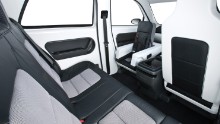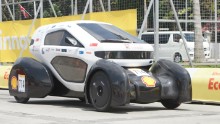

The taxi -- named EVA -- can recharge its battery in 15 minutes and cover a distance up to 200 kilometers when fully charged.
"Taxi drivers can now quickly recharge for the next part of their shifts during a break," say the creators TUM create -- a collaboration between Nanyang Technological University (NTU) and Germany's Technische Universitat München -- on their website.
According to TUM Create, taxis make up less than 3% of the vehicle population in Singapore, yet account for 15% of the total distance covered by all vehicles in Singapore, making the move towards electricity more appealing, particularly when the country's hot climate is accounted for.
Going local
With temperatures averaging above 30 degrees Celsius throughout the year, the need to keep passengers comfortable is a crucial factor when designing a vehicle in Singapore.
EVA provides this -- whilst maintaining energy efficiency -- through overhead air conditioning to cool individual seats.

EVA seats are cooled individually by an overhead air conditioning system.
"If you like it more hot and I like it more cold...we can change that," says Felix Roemer, Research Associate with TUM Create.
With the cooling system placed overhead the cool air drops down -- improving efficiency. The taxi's seats have also been designed to draw moisture away from the body as people sit on them to help reduce reliance on air conditioning.
It wouldn't be Singapore without some aspect of smart technology. This has been incorporated through a smartphone app, which passengers can use to hail a taxi, control its air conditioning and entertainment, and then pay.
But despite these advances, the challenge of adequate charging stations remains.
"Even the fastest charges that are available right not, they're not capable to deliver these high powers and currents," says Roemer, but he is confident Singapore will get up to speed to make the taxis more usable.
Green streets
The release of EVA is in line with Singapore's overall move towards green transport to both reduce reliance on fossil fuels and mitigate impact on climate change. The nation's future engineers are also stepping in to pave the way with a 3D printed solar car -- designed for the 2015 Shell Eco-marathon Asia (SEMA), which took place in February.

The NV-8, designed by students at Nanyang Technical University, is made-up of 150 parts printed in plastic to make-up the body of the car to then combine with a carbon-fiber base to produce an ulta-light car weighing just 120 kilos -- rivaling other eco-cars.
"It's like a project of love really," says Professor Ng Heong Wah who mentored the team. But Ng knows the design has its limits, as the parts took three months to complete printing for the final model.
"Faster, bigger, cheaper, more different kinds of materials," says Ng acknowledging current factors holding back the cars prosperity. "If you overcome these four obstacles I think it can be done," he says.
Ng also mentored a team behind the University's second entry into the eco-marathon -- the NV9 -- made of carbon fibre composite, polycarbonate and aluminium combined with a solar panel on its canopy to partly power the car, which went on to win awards for technical innovation and safety in the competition.






 Add Category
Add Category